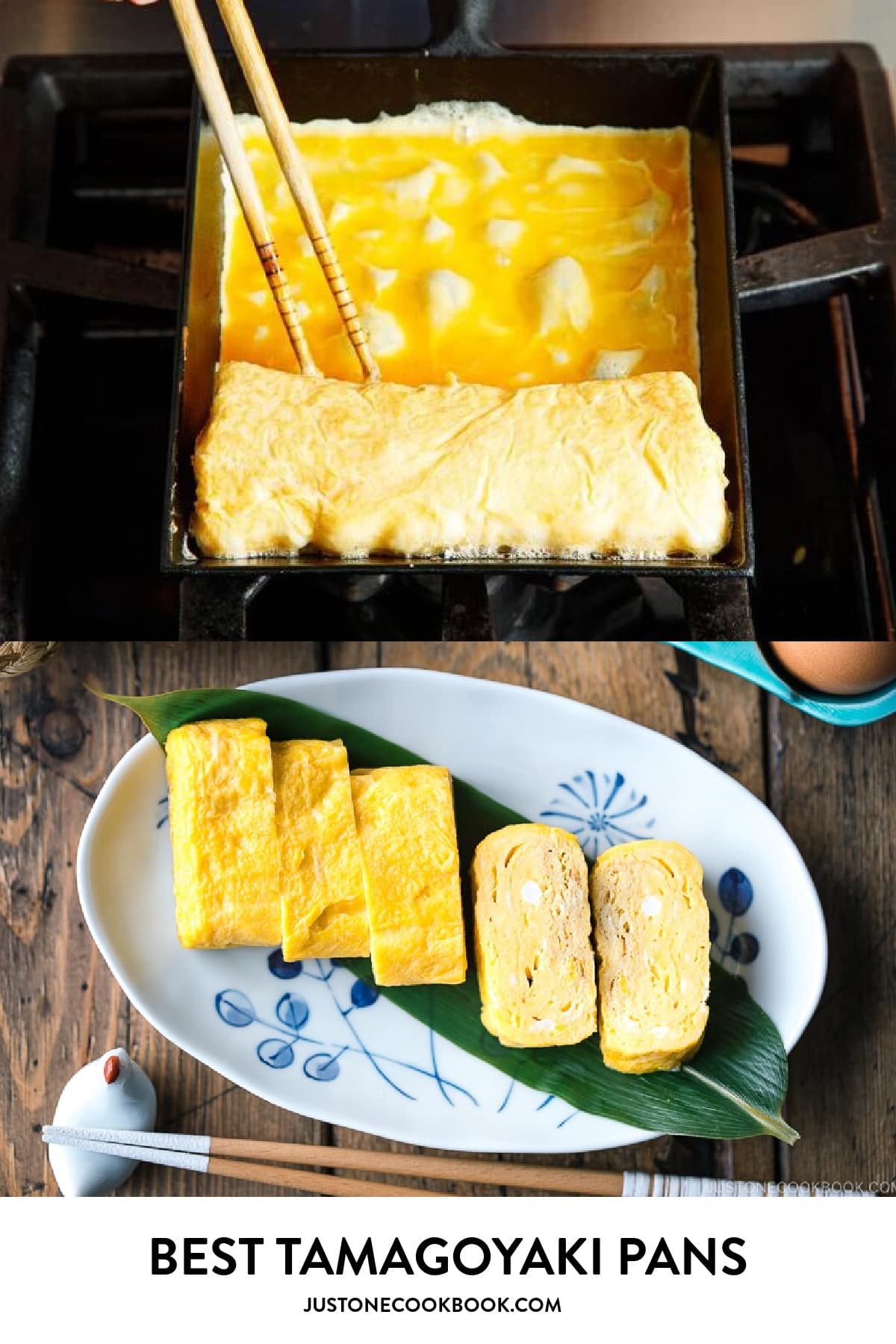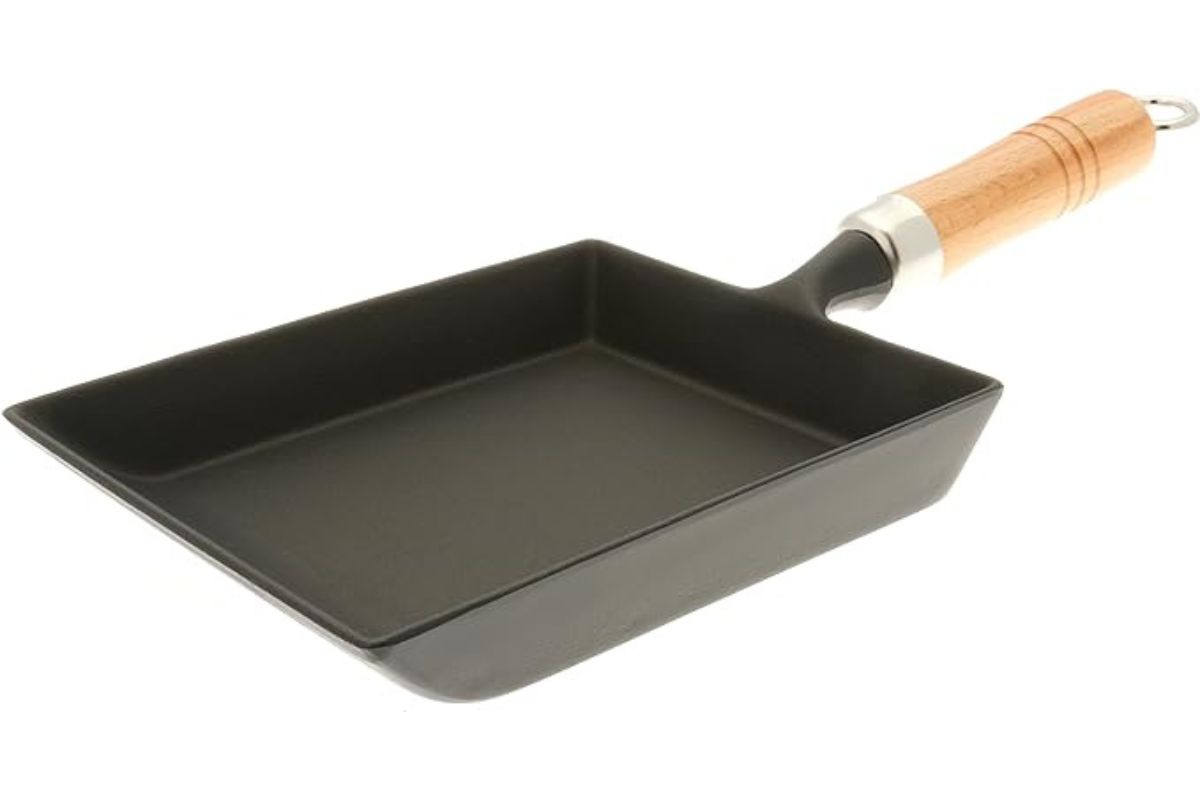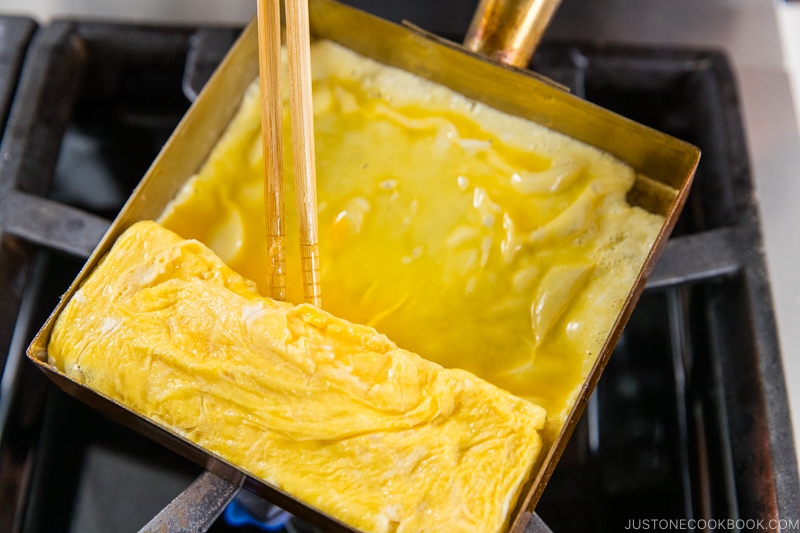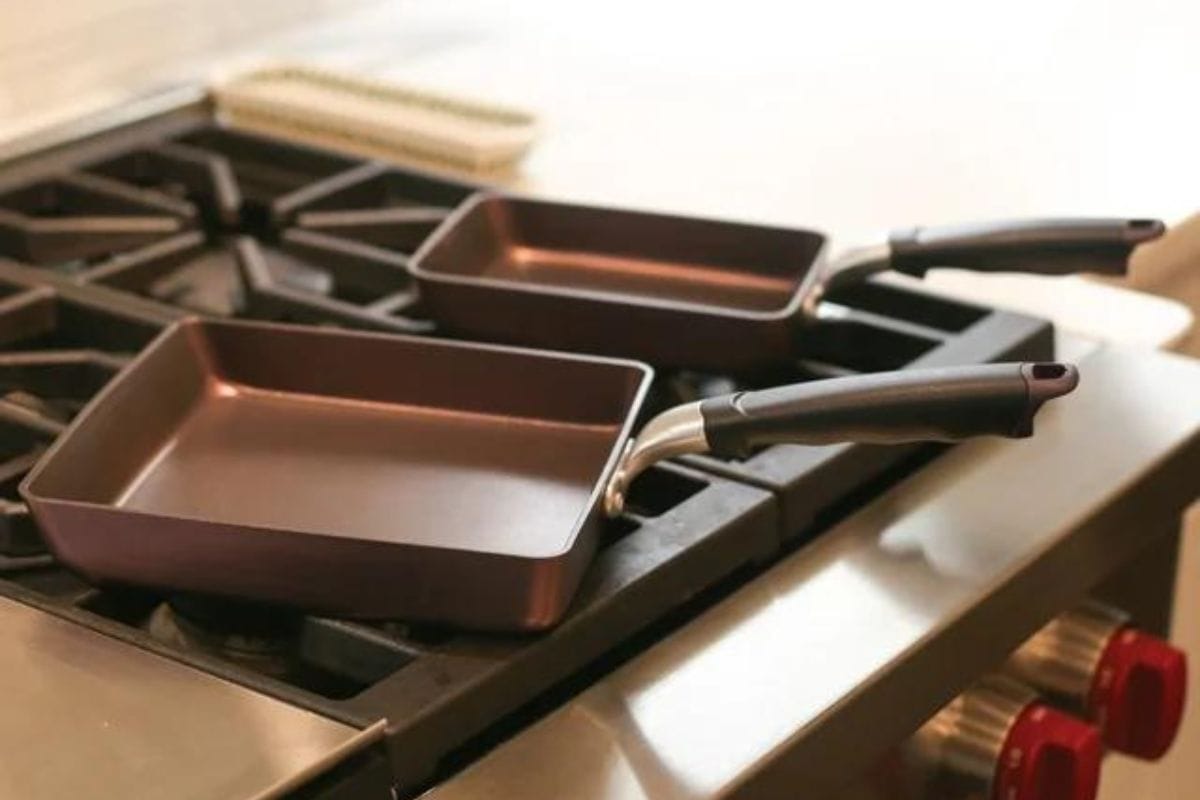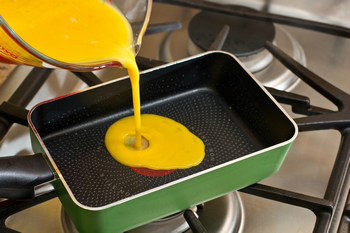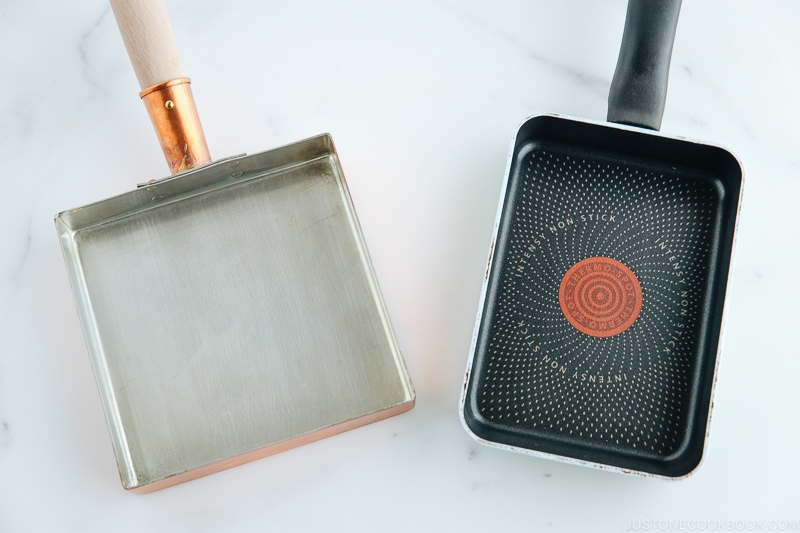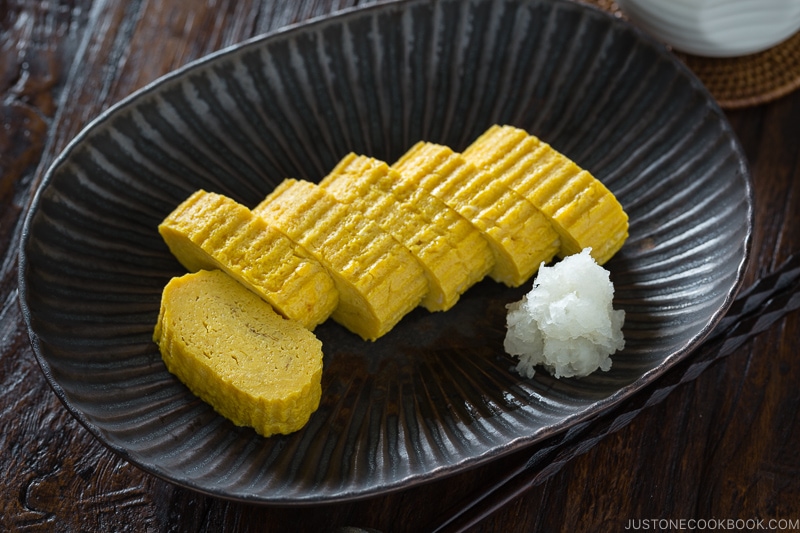One of the most iconic egg preparations in Japanese cuisine is tamagoyaki, or rolled omelette. I’ve shared various recipes on my blog: Classic Tamagoyaki (with dashi), Tokyo-style Japanese Sweet Rolled Omelet, and 3-Ingredient Simple Tamagoyaki. While it’s possible to make tamagoyaki using a standard round frying pan (more on that later), most Japanese home cooks prefer using a rectangular frying pan to make this custardy delight. Personally, I opt for the special pan because I frequently make tamagoyaki for my kids’ bento. The rectangular shape helps form a perfectly rolled log that resembles a little golden pillow every time. There’s a good selection of tamagoyaki pans available online, ranging from nonstick to copper to cast iron, and all at reasonable prices. But which model is best for your cooking style? That’s where I hope this list will be helpful.
My Top Picks
Reviews of The Best Tamagoyaki Pan
1. What’s in My Kitchen: Iwachu Iron Tamagoyaki Omelette Pan
I’ve used this cast iron tamagoyaki pan regularly for about a year now, and of all the pans I’ve used so far, this one is my favorite. I love that the egg mixture doesn’t stick even with only a little oil, and the heat distribution is even. I also like that it has a naturally nonstick material, as I am trying to avoid nonstick-coated cookware these days. The only downside of this pan is that it’s heavy, making it tiring to lift and tilt the pan to evenly distribute each egg layer. However, since I rarely cook more than a couple of tamagoyaki at a time, that weight is a small price to pay for its excellent performance. The Specs:
Dimensions: 14.25 by 6 by 1.25 inches Style: Nagoya (short, wide rectangle) Material: Cast iron with wooden handle Weight: 2.7 lbs
The Pros:
Even heat distribution Naturally nonstick Durable with proper care
The Cons:
Pricey Heavy Requires hand washing and seasoning over time
What Others Are Saying: Buy the Iwachu Iron Tamagoyaki Omelette Pan:
2. Best Even Heating: Young & Dangerous Copper Tamagoyaki Pan
If you’ve ordered tamagoyaki in a Japanese restaurant, there’s a good chance the chef used a pan that looks like this one. With its copper construction and tinned interior, it conducts heat quickly and evenly. However, I only recommend this pan for those experienced with making tamagoyaki, as you’ll have to move quickly enough to turn out perfectly shaped omelets. Otherwise, this kind of pan can be a bit of a challenge as the egg tends to stick to it unless you use a lot of oil or refine your technique. I’ve used this pan for about three years, and there was an initial learning curve. But now I love how pretty it looks and find that it’s easy to form the omelet into a nice rectangular shape. The Specs:
Dimensions: 8.27 by 6.5 by 1.97 inches Style: Kantō (square) Material: Copper pan with tinned interior, wooden handle Weight: 1.23 lbs
The Pros:
Very fast and efficient heat transfer Professional kitchen choice Stylish look Light, easy to use all day
The Cons:
Steep learning curve Eggs tend to stick Relatively small pan
What Others Are Saying: Buy the Young & Dangerous Copper Tamagoyaki Pan:
3. Best for Beginners: Techef Tamagoyaki Japanese Omelette Pan
If what you need is a simple tamagoyaki pan that’s relatively forgiving, this nonstick option from Korean company Techef may be just what you need. For about half the price of my top choice, it offers similar nonstick qualities thanks to a PFOA-free Teflon coating. The heavy-gauge aluminum core should distribute heat evenly, preventing hotspots that could overcook your eggs. It’s also both dishwasher- and oven- safe up to 350 degrees F, making it versatile and easy to clean. I used a pan just like this for over a decade and found that it’s good for those trying to cook tamagoyaki for the first time and that it will last for years to come. The Specs:
Dimensions: 7.5 by 5.5 by 1.2 inches Style: Nagoya (short, wide rectangle) Material: Aluminum pan, plastic coated metal handle Weight: 1 lb
The Pros:
Nonstick coating Forgiving for beginners Lightweight Easy to clean
The Cons:
Artificial nonstick coating material Not the most effective at distributing heat
What Others Are Saying: Buy the Techef Tamagoyaki Japanese Omelette Pan:
4. Best Budget: ROCKURWOK Nonstick Tamagoyaki Pan
If you’re not ready to invest in a high-quality tamagoyaki pan yet, this is a great, affordable option to get you started. For under $20, it has a ceramic nonstick coating, a comfortable wooden handle, and a silicone oil brush and spatula to prevent damage to the nonstick coating. It’s not dishwasher- or oven-safe, so you will have to wash it by hand. But for the low cost, this slight inconvenience might be worth it. The Specs:
Dimensions: 5.12by 7.09by 0.94 inches Style: Nagoya (short, wide rectangle) Material: Aluminum pan with ceramic nonstick coating, wooden handle. Weight: 1 lb
The Pros:
Excellent value Nonstick coating Lightweight
The Cons:
Artificial nonstick coating Distributes heat decently Not dishwasher or oven safe
What Others are Saying: Buy the ROCKURWOK Nonstick Tamagoyaki Pan:
Other Tamagoyaki Pans to Consider
FUNGYAND Tamagoyaki Pan Set
Ibili Square Japanese Omelette Pan
TIKUSAN Japanese Tamagoyaki Omelet Copper Pan
SENSARTE Japanese Omelette Pan
Why You Can Trust Me
Growing up in Japan, Tamagoyaki was one of my favorite egg dishes that my mother would cook. Today, I cook this dish regularly for my family using the method she taught me, and I’m excited to share my knowledge with you as well! When choosing my top tamagoyaki pans, I reflected on my years of experience cooking with different types of tamagoyaki pans to help choose other top-rated options. I hope that I’ve been able to provide some valuable insights that will help you pick a pan that best meets your needs!
Everything to Know Before Buying a Tamagoyaki Pan
What to Consider Before Buying a Tamagoyaki Pan
Material: Personally, I think the most important aspect to consider when choosing a tamagoyaki pan is the material. The most typical materials include:
Cast Iron: When maintained with care, cast iron can be almost nonstick. It’s a bit slow to heat, but it does a great job of distributing heat evenly. Copper Copper is one of the most desirable materials for conducting heat quickly and evenly, which is why many pro chefs use it. However, it’s not nonstick, which means eggs can stick to the pan unless you’re an experienced cook. Aluminum: It’s an affordable choice, and the nonstick coating makes it very forgiving if you’re just learning to make tamagoyaki. I personally avoid nonstick-coated pans, but they may work well for you. Stainless Steel: Eggs tend to stick to it unless you use a lot of oil. I generally wouldn’t recommend it for tamagoyaki. Carbon Steel: Somewhere between stainless steel and cast iron in terms of performance, but eggs can still stick. I generally don’t recommend it when making this dish.
Size: You’ll also want to consider the size and weight of your pan. Naturally, if you’ll be cooking more tamagoyaki for large groups, a larger pan may be preferable. Do keep in mind the weight, though. A pan that is too heavy can be difficult to maneuver. Nonstick: As mentioned earlier, I am currently avoiding nonstick-coated pans, but some, like copper and cast iron, are naturally nonstick. These materials are a bit more expensive, but they are worth it for their quality.
What is Tamagoyaki?
In Japanese, tamago means egg, and yaki means grill, so tamagoyaki is a compound word that essentially means ‘grilled egg’. In Japanese cuisine, tamagoyaki usually refers to a rolled egg omelet, which tastes mildly sweet and savory and has a light, pillowy texture. Like most Japanese culinary staples, there are regional variations of tamagoyaki. Served sliced into pieces, tamagoyaki is an important part of Japanese breakfasts, lunch bento meals, and sometimes even high-end sushi dinners. While it can take time to master making tamagoyaki, it’s easy enough to make at home—especially if you have the right tools.
Can You Cook Tamagoyaki in a Round Pan?
It is possible to make tamagoyaki using a standard round frying pan. As long as you are willing to accept that your finished tamagoyaki from a round pan may not look quite as neat as that from a rectangular pan, you can mimic the standard tamagoyaki shape in a round pan. I have instructions for cooking tamagoyaki in a round pan, in my Tamagoyaki (Japanese Rolled Omelette) recipe.
How Do You Season Tamagoyaki Pan?
If you purchase a cast iron or carbon steel tamagoyaki pan that doesn’t come pre-seasoned, you will need to season the pan before cooking in it. The seasoning process develops a natural nonstick layer on the pan, which will allow you to easily cook your tamagoyaki without using too much oil. You’ll need to wash and dry your pan, add vegetable oil to the pan, and bring it to high heat to start developing your nonstick layer. Once you’ve seasoned your pan, be sure to maintain that nonstick layer by washing it only with warm water and a towel—no soap! For an in-depth guide to the seasoning process, please check out my guide on How To Season A Carbon Steel Pan.
Can You Freeze Tamagoyaki?
If you get carried away practicing with your new tamagoyaki pan and make more eggs than you can eat in one day, you can refrigerate your leftovers in an airtight container for up to three days. You can also freeze it in an airtight container for up to a month, defrost it overnight in the refrigerator, and reheat it in the microwave.
The Best Tamagoyaki Recipes
The variations on tamagoyaki and the ways in which these rolled omelets can be used are near limitless. Below are a few of my favorite variations as well as bento box lunch ideas you can serve with your tamagoyaki:
3-Ingredient Simple Tamagoyaki (for the beginners) Tamagoyaki (Japanese Rolled Omelette) (Dashimaki Tamago) (more advanced) Japanese Sweet Rolled Omelet (Tamagoyaki) (Atsuyaki Tamago) (more advanced) Quick & Easy Tamagoyaki Karaage Bento with Tamagoyaki
Prices were accurate at time of publication.
